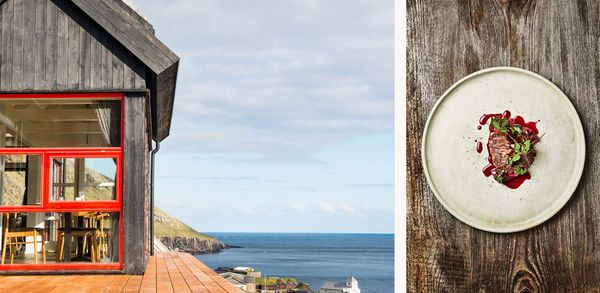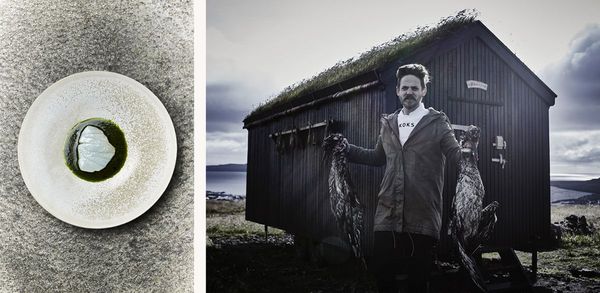
Northern star: how one chef put the Faroe Islands on the world’s culinary map
Chef Poul Andrias Ziska tells us how tradition meets innovation in his cooking and why sea-breeze fermentation is something we need to try
Words Anastasia Bernhardt
Photography Claes Bech-Poulsen

Isolated by the icy seas of the North Atlantic, the Faroe Islands have a distinctive food culture shaped by the harsh weather the region endures for most of the year. Like many Scandinavian countries, Faroese culture has created distinct methods for preserving and storing meat, poultry and fish for the long, punishing winter. The most notable technique is called raest – the Faroese word for ‘fermented’.
Raest is a dry fermentation process by which meat, poultry and fish are cured outdoors in the salty ocean air in specially designed huts called hjallur, found across the islands. Few vegetables can survive the windy and cold conditions above ground, so root vegetables like potatoes and turnips are commonly grown.
Classic dishes may be a little intimidating but serious foodies looking for something unique will take to them with ease.
While other Nordic countries have seen a massive interest in their cuisines, the Faroese tradition has, until recently, remained relatively undiscovered. That is until chef Poul Andrias Ziska put the archipelago on the foodie map, winning the Faroe Islands its first Michelin star at his restaurant, KOKS in Kirkjubøur, a village south of the capital Tórshavn. Taking traditional dishes, techniques and ingredients, he is plating up an elegant interpretation of Faroese cooking to excite the 21st-century palate.
Here, Ziska gives us the low-down on his interpretation of Faroese cooking.


Gaggenau: What’s so distinctive about the Faroe Islands’ cuisine?
Poul Andrias Ziska: You’re never more than five km from the sea at any point on the island, so we have the most incredible seafood. It’s so fresh and of such high quality! We also have a fairly unique tradition of fermenting meat, particularly lamb.
Gaggenau: What do you mean by ‘fermented’ meat?
PAZ: It’s a completely uncontrolled process: we don’t add any salt, we don’t smoke the meat, nor is it hung in fridges. We hang carcasses in a barn, allowing the sea breeze to get into the meat, exposing it to the natural yeast and salt in the air, which starts the fermenting process. The taste of it always reminds me of Christmas, when my family used to gather at my grandmother’s for dinner.

‘ About 10 years ago there were very few restaurants here and the food you ate was caught by you or your friends ‘

Gaggenau: Given the remote nature of the island, what challenges do you face?
PAZ: We don’t have a strong culture of growing vegetables, but that’s something that’s changing. The short season here is a real challenge, so we have to preserve a lot of things, which adds an extra dimension to our cooking but can also be quite limiting. Traditionally, the four vegetables grown here were turnips, swede, potatoes and rhubarb. But now people are growing garlic, leeks, onions, parsnips, radish, lettuce, salads and kale.
Gaggenau: But at least you’re never short of fresh fish, right?
PAZ: Ironically when we first opened the restaurant, we couldn’t get hold of fresh fish because it was all being exported. Luckily, that’s not the case anymore. About 10 years ago there were very few restaurants and the food you ate was usually caught by you or your friends, but now the restaurant scene has developed, so there’s a market for it.
Gaggenau: What’s the ethos behind KOKS?
PAZ: It’s a space to showcase the raw materials that we have on the island and to celebrate our culture and food traditions in a way that’s presentable. My cooking is fairly simple, without being too ‘natural’. You need some technique and personality behind your cooking.
Gaggenau: Does the look of restaurant reflect the Faraoese traditions?
PAZ: It’s a modern house but with traditional lines and a grass roof, and it’s very cosy. We asked a musician to make a soundscape by recording noises from around the Faroe Islands, such as birds tweeting or a ferry coming into the harbour. The plates we use are made by ceramists inspired by the nature around us. But we’re actually moving from this space at the end of the year.


Gaggenau: What’s your most interesting dish?
PAZ: If you go to any birthday or wedding on the Faroe Islands you’ll be served kleinur [a fried pastry] – we’ve taken away the sweetness of this cookie by replacing the cardamom and sugar with cheese and salt, and topped it with fermented lamb tallow. Faroese people recognise the cracker and its crumbling texture but the flavours are so different.
Gaggenau:What’s a typical dish that we couldn’t taste elsewhere?
PAZ: At KOKS we reinterpret a lot of traditional dishes; for example, we ferment cod in the open air and cook it with potatoes – we use potatoes with almost everything here – then dress it with a sauce made from lamb guts, which are cleaned and left to hang in the fermenting barn for up to six weeks, before being minced. I’d describe the flavour as having ‘blue cheese notes’ – and that can be challenging for some people who aren’t used to that taste!
Gaggenau: Where do you source your ingredients?
PAZ: We work very closely with local suppliers. Our fishermen only fish by line and all our seafood is personally hand-dived by one of my friends. We forage most of the herbs we use in the restaurant and use a lot of seaweed from the coastline. Depending on the season, at any one time there could be up to five different varieties of seaweed on the menu and ten local herbs, including pineapple weed, monkey flower and sorrel.
Gaggenau: Why do you think the Faroe Islands are attracting more visitors?
PAZ: People are increasingly adventurous, always looking to experience something that hasn’t been put on the map yet. I think the Faroe Islands are definitely one of those places, here it’s so mystical and small, plus the nature is amazing.
Gaggenau: Finally, congratulations on winning the country’s first Michelin star. Did it come as a surprise?
PAZ: We weren’t expecting it at all – we first heard about it on Twitter. It was the biggest shock for us and we didn’t really know what to expect. The most surprising thing for us was that they came all the way up here. We threw a big party for all the staff to celebrate!
